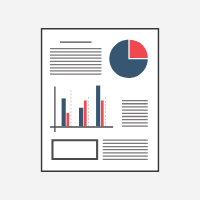Quick Guide: The Debt to Equity Ratio
Today we’ll cover the debt to equity ratio:
- How it is calculated,
- What it is, and
- What it measures.
We’ll also calculate a debt to equity ratio example, and see how it can help improve your financial analysis.
Let’s dive right in.
How to Calculate Debt to Equity Ratio Formula
The debt to equity ratio is calculated by dividing a company’s total debt by total stockholders equity.
Debt to Equity Ratio Formula = Total Debt / Total Equity
When calculating total debt, you should use the sum of the company’s long-term debt and short-term debt:

These amounts are shown separately on a company’s balance sheet.
The amount that is included under the heading, “Current Liabilities,” is the sum of the loan payments the company will be required to make over the next 12 months.
While the amount in the line-item, “Long-Term Debt,” is the sum of the payments required on outstanding debts from 13 months through the maturity date of the loan(s).
The sum of those two numbers gives you the company’s total debt, which you’ll use to calculate the company’s ratio of debt to equity.
What Does the Debt to Equity Ratio Measure
This ratio is part of a larger family of financial ratios known as leverage ratios.
Leverage ratios measure how much of a company’s capital is generated from loans, compared to equity.
Leverage ratios also measure a company’s ability to meet its required debt and interest payments going forward.
Check out our deep dive into leverage ratios for more information.
The debt to equity ratio specifically focuses on measuring a company’s debt compared to it’s equity.
What is a good debt to equity ratio
Analyzing whether a company has a good debt to equity ratio depends on various factors:
- The nature of the company’s operations,
- The trend of the company’s ratio over time, and
- How the company’s debt/equity ratio measures up to its peer group and industry competitors.
A high debt to equity ratio means a company utilizes more debt than equity to finance its operations.
If that is the case, it’s important to understand the increased risk factors that come with carrying high amounts of debt.
The higher debt a company has, the more it is impacted by general economic factors.
For example, let’s say a company carries a ton of debt that includes a variable interest rate.
If interest rates go up because of an action by the Government, the Company’s expenses will increase along with it’s interest burden.
This leads to lower profitability, all because of a change that was completely outside of the Company’s control.
A higher debt to equity ratio may also indicate that the Company is forced to borrow money to finance operations.
If a company’s operating cash flows aren’t sufficient to support ongoing operations, the Company can either raise additional cash from investors, or borrow the cash from a bank.
Raising cash from investors may dilute your ownership interest in the stock, but it is generally a lower cost source of capital than debt.
An Example of The Debt to Equity Ratio
Let’s take a look at a quick example of the debt/equity ratio (numbers in thousands, $USD):
Apple Inc. (AAPL) reported short term debt of $18,473,000 and long-term debt of $97,207,000 at September 30, 2017.
Apple also reported total equity of $134,047,000 on that same date.
Using the formula we outlined above, you would first calculate total debt:
115,680,000 = (18,473,000 + 97,207,000)
Which you would then use to calculate the debt to equity ratio:
0.86 = 115,680,000 / 134,047,000
The Company’s debt/equity ratio of 86% means that 86% of its capital is generated from debt.
You can see that over time, Apple’s capital structure has slowly shifted, and more debt is being used to finance operations:
+Debt-Equity+Ratio.PNG)
What's Next?
A company’s debt to equity ratio gives you insight into their financial leverage and the sources of capital used to run their business.
Using the debt/equity ratio calculator before investing in a stock can help identify risk prior to investing in a company.
And, if you're calculating the debt to equity ratio of a U.S. publicly traded company, you can skip all of these steps and let our stock analysis software calculate the ratio for you:
Find the Debt to Equity Ratio for any U.S. Stock
Or
Use one of our other stock analysis or stock research tools:
- Head over to our stock analysis page and search for a stock to start your analysis
- Quickly calculate financial metrics using our collection of financial calculators
- Use our fundamental stock screener to filter and screen for awesome companies
- Ready for another blog post? Check out our deep dive into finding undervalued stocks to buy in 2019







